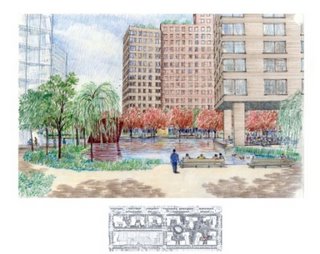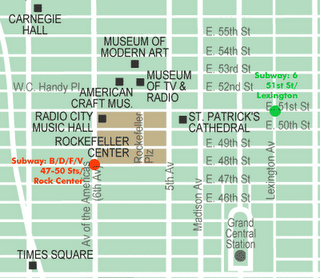 It's a word that Forest City Ratner and architect Frank Gehry dare not speak: superblock. Nobody loves a superblock. The discredited feature of 1960s mega-designs, according to the Getty Art & Architecture Thesaurus, "designates very large, usually residential, city blocks often formed by consolidating several smaller blocks and often barred to through traffic and crossed by pedestrian walks." (Overlay site plan from Develop Don't Destroy Brooklyn.)
It's a word that Forest City Ratner and architect Frank Gehry dare not speak: superblock. Nobody loves a superblock. The discredited feature of 1960s mega-designs, according to the Getty Art & Architecture Thesaurus, "designates very large, usually residential, city blocks often formed by consolidating several smaller blocks and often barred to through traffic and crossed by pedestrian walks." (Overlay site plan from Develop Don't Destroy Brooklyn.)And that's what would happen in the eastern section of the proposed Atlantic Yards project: Pacific Street would be demapped. (See graphic below.)
 That allows Forest City Ratner, already facing the challenge of much too little open space for the expected population, to gain some three acres of the proposed seven acres for privately-run parks. The superblock also would allow the developer to claim a lesser Floor Area Ratio (FAR) than a project that didn't absorb the street. Note that Pacific Street and Fifth Avenue in the western portion of the site also would be demapped, creating another superblock; with an arena at the center, it certainly would depart from a classic superblock.
That allows Forest City Ratner, already facing the challenge of much too little open space for the expected population, to gain some three acres of the proposed seven acres for privately-run parks. The superblock also would allow the developer to claim a lesser Floor Area Ratio (FAR) than a project that didn't absorb the street. Note that Pacific Street and Fifth Avenue in the western portion of the site also would be demapped, creating another superblock; with an arena at the center, it certainly would depart from a classic superblock.But creating "towers in a park" is frowned on these days; the community-developed UNITY plan, by contrast, proposed extending streets from Fort Greene to better connect the neighborhood with Prospect Heights and Park Slope.
A chorus against superblocks
 Superblocks come in for regular criticism. Julia Vitullo-Martin observed in the March 2005 Manhattan Institute newsletter:
Superblocks come in for regular criticism. Julia Vitullo-Martin observed in the March 2005 Manhattan Institute newsletter:The superblock erased New York's tight street grid, famously maligned by writer Lewis Mumford as the soulless invention of commercial capitalism, a pernicious device for dividing land into salable parcels. But today we recognize that Mumford was utterly wrong.
(Graphic from NoLandGrab.org)
In a review of Philip Nobel's book on Ground Zero, Sixteen Acres, Clay Risen wrote in the 1/30/05 New York Times:
For residents of nearby neighborhoods, it provided an opportunity to correct the massive planning mistake that was the original World Trade Center superblock.
Regarding the Atlantic Yards plan, Brooklyn developer David Walentas on 10/10/05 told the New York Observer's blog The Real Estate:
“I think the Nets are good. I think the transportation is good. I think the housing is too dense and I think the superblocks they have there is a bad idea. I think superblocks don’t work anywhere in America. I think you need streets between buildings. You need traffic and pedestrians for safety and activity and shops and restaurants. But architects like these utopian kinds of ideas. They don’t work…"
Who notices the Atlantic Yards superblock?
 The term has been used infrequently in public discussions of the Atlantic Yards plan. The New York Observer used the term in a caption (graphic at right) in its 5/11/06 report in The Real Estate on Frank Gehry's press conference.
The term has been used infrequently in public discussions of the Atlantic Yards plan. The New York Observer used the term in a caption (graphic at right) in its 5/11/06 report in The Real Estate on Frank Gehry's press conference.The authoritative trade magazine Architectural Record, in a 5/17/06 article headlined Revised Atlantic Yards Plan Less Bulky, Yet Still Huge, laid it out:
The eastern edge of the site, which creeps into the more residential, low-density neighborhood of Prospect Heights, would form a superblock, with seven residential buildings of 20 to 40 stories.
This week, New York magazine didn't quite spell it out, but suggested an alternative plan with "No more 300- and 400-foot slabs surrounding a park."
Architecture critics punt
Have architectural critics writing about the project used the term? Not James Gardner, in his 5/16/06 piece in the Sun. Not Justin Davidson, in his 5/22/06 assessment in Newsday. Dan Bischoff, in his 5/28/06 review in the Star-Ledger, didn't use the term but did criticize the design mentality:
But this design looks less like the new Shanghai than the old Eastern Europe, with its enormous high-rise blocks that bring a Le Corbusier geometric fantasy to mind.
Muschamp's myopia
 The two biggest raves for the design, albeit earlier iterations of it, have come from the two New York Times architecture critics. Herbert Muschamp, in a 12/11/03 review headlined Courtside Seats to an Urban Garden, not only didn't mention the superblock, he had the gall to compare Atlantic Yards to Rockefeller Center, writing:
The two biggest raves for the design, albeit earlier iterations of it, have come from the two New York Times architecture critics. Herbert Muschamp, in a 12/11/03 review headlined Courtside Seats to an Urban Garden, not only didn't mention the superblock, he had the gall to compare Atlantic Yards to Rockefeller Center, writing:Those who have been wondering whether it will ever be possible to create another Rockefeller Center can stop waiting for the answer. Here it is.
But Rockefeller Center was no superblock. It added a new street, Rockefeller Plaza, to the street grid, rather than subtracted streets. (Map from About.com.)
Ouroussoff's redefinition
Nicolai Ouroussoff, in his 7/5/05 review, headlined Seeking First to Reinvent the Sports Arena, and Then Brooklyn, declared Gehry's design "an intriguing attempt to overturn a half-century's worth of failed urban planning ideas."
He went on to make a distinction between superblocks and developments that may look like superblocks but, in his judgment, do not qualify as such:
From the dehumanizing Modernist superblocks of the 1960's to the cloying artificiality of postmodern visions like Battery Park City, architects have labored to come up with a formula for large-scale housing development that is not cold, sterile and lifeless.
...Extending east from the arena, the bulk of the residential buildings are organized in two uneven rows that frame a long internal courtyard. The buildings are broken down into smaller components, like building blocks stacked on top of one another. The blocks are then carefully arranged in response to various site conditions, pulling apart in places to frame passageways through the site; elsewhere, they are used to frame a series of more private gardens.
Ouroussoff maintained this distinction in a public appearance with Gehry in January, asserting that the Atlantic Yards design wouldn't involve a superblock. However, the definition cited above says nothing about whether the buildings are "dehumanizing" or "carefully arranged." A superblock is created when large blocks are formed by consolidating streets, usually for residential buildings.
Other coverage
I could find only a few other mentions of a superblock in press coverage. The Brooklyn Papers' Vince DiMiceli, in a 10/16/04 opinion piece headlined Bring Mets and Nets to Brooklyn, wrote:
And while any of those would be better than Ratner’s suburban campus superblock — which would complete the separation of Fort Greene and Clinton Hill from Prospect Heights that he started with the failed Atlantic Center mall — none of them are going to happen.
A 3/11/06 editorial in The Brooklyn Papers, headlined Yards plan not just Nets, stated:
Ratner says the project’s elimination of the Long Island Rail Road “cut” will heal an open wound that separates Fort Greene from Prospect Heights, but those towers and that superblock will actually do the opposite, permanently cutting the neighborhoods off from each other.
A Lexis-Nexis search of news coverage turned up three other examples. A 7/22/05 article in the New York Sun, headlined Report: Arena Vulnerable to Terrorists, quoted a report on security issues:
"Unfortunately, once these security measures are implemented, the complex will become a fortress-like superblock,” according to the report.
A 9/26/05 article in the New York Observer, headlined At W.T.C. and Brooklyn Arena, Death and Life of the Superblock, noted:
Add to that a project in Brooklyn that seeks to create a superblock where there isn’t one, and scattered calls to bring back Robert Moses, and this isn’t looking like a great season for the legacy of Jane Jacobs.
...But there certainly is one aspect of Mr. Gehry's design for Atlantic Yards that Ms. Jacobs wouldn't like: superblocks.
FCR on the record
And reporter Matthew Schuerman got Forest City Ratner on the record:
"For FCRC, it is less about superblocks and more about working blocks," Mr. [Jim] Stuckey said in an e-mail. "What we like most about the plan is how the buildings and the public space respect one another and surrounding areas by encouraging movement along the sidewalk and within the interior. These buildings will very much look out to the larger city and surrounding communities while creating a public space that remains alive because it too is open to the street."
Note Stuckey's effort at Changing the Subject, which is Tactic #4 in the Joe DePlasco playbook.
Just the bloggers?
And the Times, in a 4/16/06 article about bloggers, cited Jonathan Cohn, the architect behind the Brooklyn Views blog:
His argument -- that the Atlantic Yards would be more dense than advertised because it eliminated otherwise open city streets to create the "superblock" on which the project will be built -- was quickly added to opponents' talking points.
But is the superblock a subject just for bloggers and opponents, or should it be part of the ongoing discussion of the Atlantic Yards project?
Comments
Post a Comment